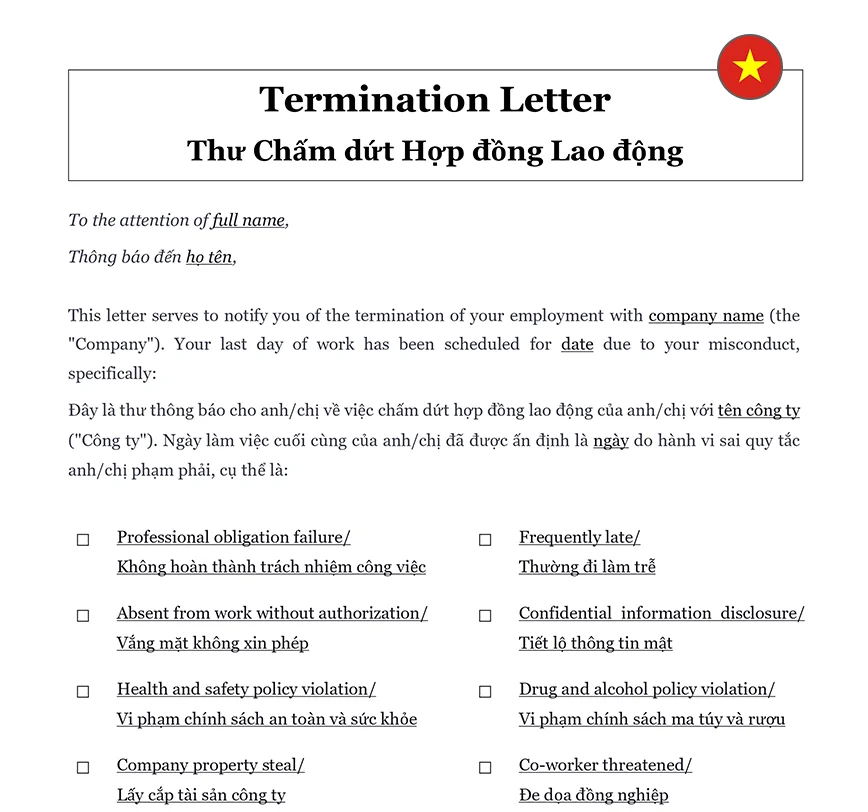Ready to use legal template
Drafted by experienced lawyers
Vietnamese-English translation
Ready to use legal template
Drafted by lawyers
Vietnamese-English translation
Learn more about Employment Termination Letter in Vietnam
An Employment Termination Letter is an official document used by employers to formally notify an employee of the end of their employment. It serves as a crucial record of the termination, outlining key details such as the effective date, reasons for termination, final compensation, and any post-employment obligations. In Vietnam, termination procedures must comply with the Labor Code of Vietnam, ensuring fair treatment of employees and adherence to legal requirements, including notice periods and severance entitlements. To ensure compliance with Vietnamese labor laws and maintain professionalism in employment matters, download our easy-to-edit Employment Termination Letter in Word format, expertly drafted in both English and Vietnamese, to help your business handle termination procedures efficiently and legally.
Table of contents
-
What is an Employment Termination Letter?
-
What is included in an Employment Termination Letter?
-
How is it different from a resignation letter?
-
How to deliver an Employment Termination Letter in Vietnam?
-
What are the consequences of not issuing an Employment Termination Letter?
-
What are the laws or regulations in Vietnam regarding termination letters?
-
What is the notice period in an Employment Termination Letter in Vietnam?
-
Can an employee request changes to it in Vietnam?
What is an Employment Termination Letter?
An Employment Termination Letter serves as a formal and legally recognized means of concluding the employment relationship between an employer and an employee. It is a pivotal document that encapsulates the decision to terminate employment, articulating the reasons behind the decision, whether it be due to performance issues, restructuring, or other business-related reasons. Beyond a mere notification, it establishes clarity and transparency, ensuring that both parties understand the circumstances surrounding the termination. By detailing the terms of separation, such as the effective date of termination and any relevant severance packages or benefits, the letter provides a structured framework for the transition out of the organization.
An Employment Termination Letter serves as a vital record in the event of any future disputes or legal proceedings. It documents the employer’s adherence to due process and compliance with relevant employment laws and regulations, thus mitigating potential risks associated with wrongful termination claims. From a practical standpoint, it also serves as a reference point for both the employer and the departing employee, clarifying expectations and facilitating a smooth transition. In essence, an Employment Termination Letter is not just a formality; it is a strategic tool that fosters accountability, professionalism, and fairness in the termination process, ultimately safeguarding the interests of all parties involved.
What is included in an Employment Termination Letter?
Employer Information: Name and address of the employer or company issuing the letter.
Employee Information: Name, job title, department, and any other relevant employment details of the employee being terminated.
Reason for Termination: A clear and concise explanation of the reason(s) for termination, such as poor performance, misconduct, redundancy, or other business-related factors.
Effective Date of Termination: The specific date on which the termination becomes effective. This is crucial for determining final pay, benefits cessation, and other logistical arrangements.
Details of Final Pay and Benefits: Information about the employee’s final paycheck, including any accrued but unused vacation or sick leave, as well as details regarding the continuation or cessation of benefits.
Return of Company Property: Instructions for the return of any company-owned property, such as keys, access cards, laptops, or other equipment.
Non-Disclosure and Non-Compete Obligations: Any post-employment obligations, such as confidentiality agreements or non-compete clauses, that the employee must adhere to after termination.
Severance Package (if applicable): Details regarding any severance pay or benefits offered to the terminated employee, including eligibility criteria and payment terms.
Acknowledgment of Receipt: A section for the employee to acknowledge receipt of the termination letter, confirming that they have received and understood its contents.
Next Steps: Guidance on any next steps the employee needs to take, such as returning signed documents, scheduling exit interviews, or transitioning responsibilities.
How is it different from a resignation letter?
An Employment Termination Letter and a resignation letter serve different purposes and are initiated by different parties in the employment relationship.
1. Employment Termination Letter
An Employment Termination Letter is typically issued by the employer to formally notify an employee of the decision to end their employment. It provides details such as the reason for termination, the effective date of termination, any final pay and benefits, and instructions for returning company property. The Employment Termination Letter is initiated by the employer and serves as a formal record of the termination decision.
2. Employee Resignation Letter
An Employee Resignation Letter is initiated by the employee to inform the employer of their decision to voluntarily resign from their position. It typically includes the employee’s intention to resign, the effective date of resignation, and a brief expression of gratitude for the opportunity to work with the company. A resignation letter serves as formal notice of the employee’s intent to leave the company and is often submitted in advance of the intended last day of work.
ℹ️ Themis Partner also offers a comprehensive Employee Resignation Letter template, meticulously crafted to streamline the resignation process with professionalism and clarity.
How to deliver an Employment Termination Letter in Vietnam?
In Vietnam, delivering an Employment Termination Letter typically involves adhering to certain protocols to ensure legality and professionalism. Here are the steps typically followed:
1. Prepare the Letter:
Draft the Employment Termination Letter, ensuring it includes all necessary details such as the reason for termination, effective date, and any other relevant information.
2. Arrange a Meeting and Present the Letter:
Schedule a meeting with the employee to discuss the termination. This meeting should be conducted in private and with sensitivity to the employee’s feelings. During the meeting, present the Employment Termination Letter to the employee. Hand it to them in person and explain its contents clearly and respectfully.
3. Allow Time for Discussion and Provide Support:
After presenting the letter, allow the employee time to ask questions or seek clarification. Be prepared to address any concerns they may have. Offer support to the employee during this challenging time. This may include assistance with understanding their rights, guidance on next steps, or access to counseling services if needed.
4. Obtain Acknowledgment:
Ask the employee to sign a receipt or acknowledgment of receipt to confirm that they have received the Employment Termination Letter and understand its contents. This helps document the termination process.
5. Follow Up:
Follow up with the employee after the meeting to ensure they have everything they need and to provide any additional support or assistance if required.
By following these steps, employers can deliver Employment Termination Letters in Vietnam in a professional, respectful, and legally compliant manner.
What are the consequences of not issuing an Employment Termination Letter?
The consequences of not issuing an Employment Termination Letter can vary depending on the circumstances and jurisdiction, but they can generally include legal, financial, and operational risks for the employer. Here are some potential consequences:
| ➤ Legal Risks: Failure to provide a formal notice of termination in writing may lead to allegations of wrongful termination or unfair dismissal by the employee. Without documented evidence of the termination decision and its reasons, the employer may face legal challenges and potential lawsuits. |
| ➤ Breach of Contract: If the termination is in violation of the employment contract or any applicable laws or regulations, the employer may be liable for breaching contractual obligations, leading to legal disputes and financial penalties. |
| ➤ Employee Misunderstanding: Without a clear and formal notification, the terminated employee may misunderstand the reasons for termination or the terms of separation, leading to confusion, resentment, or disputes. |
| ➤ Loss of Documentation: An Employment Termination Letter serves as a critical piece of documentation for the employer, providing a record of the termination decision, the reasons behind it, and any agreed-upon terms. Without this documentation, it may be challenging for the employer to defend against legal claims or disputes. |
| ➤ Operational Disruption: Failing to issue an Employment Termination Letter in a timely manner can lead to operational disruptions, as the terminated employee may continue to have access to company resources, sensitive information, or responsibilities beyond their termination date. |
| ➤ Reputational Damage: Mishandling the termination process, including the failure to provide proper documentation, can damage the employer's reputation among current and potential employees, clients, and business partners. |




